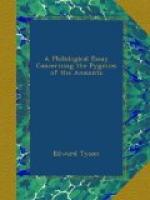It is impossible not to see a connection between such conceptions as these and the underground habitations of the little people entered by the green mound which covered the bones of the dead. But the underground world was not only associated with the shades of the departed; it was in many parts of the world the place whence races had their origin, and here also we meet in at least one instance known to me with the conception of a little folk. A very widespread legend in Europe, and especially in Scandinavia, according to Dr. Nansen, tells how the underground or invisible people came into existence. “The Lord one day paid a visit to Eve as she was busy washing her children. All those who were not yet washed she hurriedly hid in cellars and corners and under big vessels, and presented the others to the Visitor. The Lord asked if these were all, and she answered ‘Yes;’ whereupon He replied, ’Then those which are dulde (hidden) shall remain hulde (concealed, invisible). And from them the huldre-folk are sprung."[A] There is also the widespread story of an origin underground, as amongst the Wasabe, a sub-gens of the Omahas, who believe that their ancestors were made under the earth and subsequently came to the surface.[B] There is a similar story amongst the Z[=u]nis of Western New Mexico. In journeying to their present place of habitation, they passed through four worlds, all in the interior of this, the passage way from darkness to light being through a large reed. From the inner world they were led by the two little war-gods, Ah-ai-[=u]-ta and M[=a]-[=a]-s[=e]-we, twin brothers, sons of the Sun, who were sent by the Sun to bring this people to his presence.[C] From these stories it would appear that the underground world, whether looked upon as the habitation of the dead or the place of origination of nations, is connected with the conception of little races and people. That it is thus responsible for some portion of the conception of fairies seems to me to be more than probable.
[Footnote A: Nansen, ut supra, p. 262.]
[Footnote B: Dorset, Omaha Sociology. American Bureau of Ethnology, iii. 211.]
[Footnote C: Stevenson, Religious Life of Zuni Child. American Bureau of Ethnology, v. 539.]
It is hardly necessary to allude to those spirits which animistic ideas have attached amongst other objects and places, to trees and wells. They are fully dealt with in Dr. Tylor’s pages, and must not be forgotten in connection with the present question.
To sum up, then, it appears as if the idea, so widely diffused, of little, invisible, or only sometimes visible, people, is of the most complex nature. From the darkness which shrouds it, however, it is possible to discern some rays of light. That the souls of the departed, and the underground world which they inhabit, are largely responsible for it, is, I hope, rendered probable by the facts which I have brought forward. That animistic ideas have




